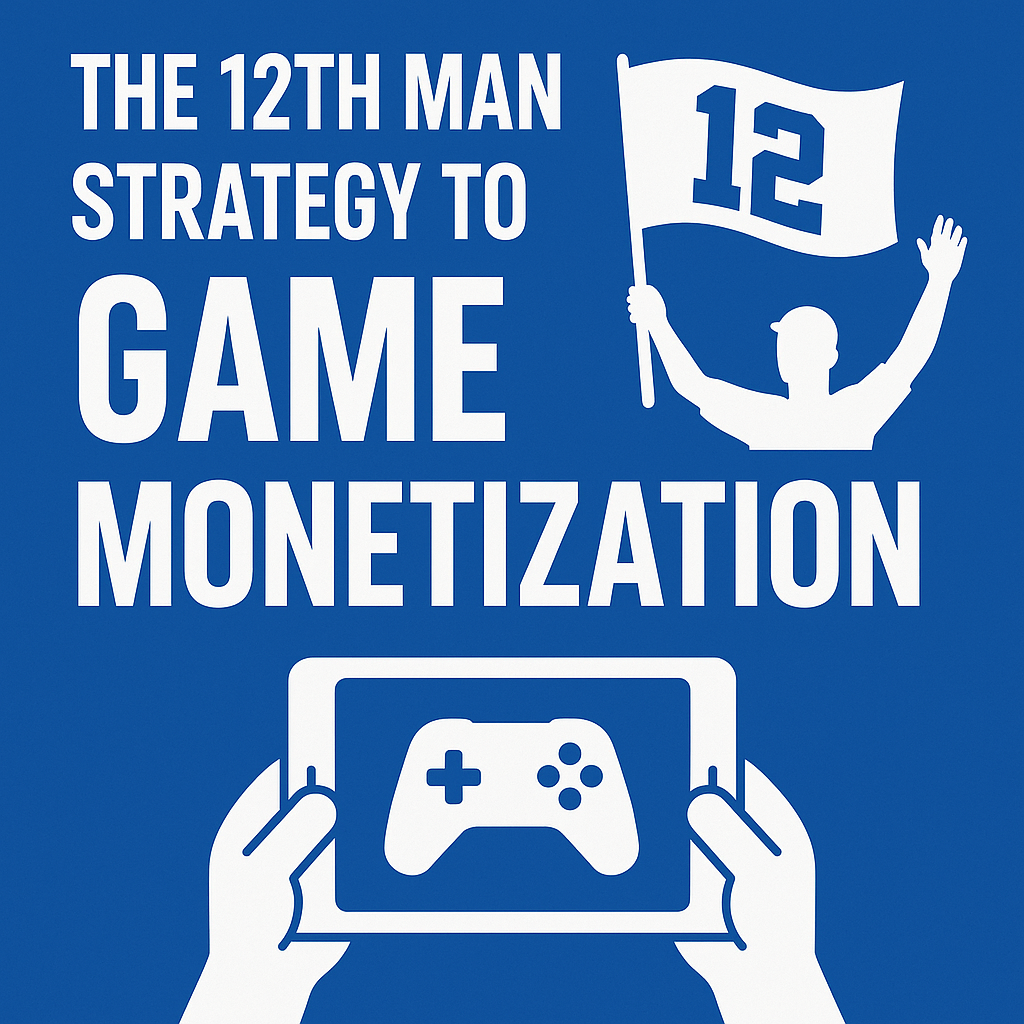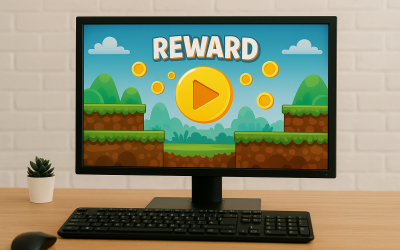The 12th Man Strategy to Game Monetization
When the Seattle Seahawks retire a jersey number, it’s usually to honor a legendary player. But jersey number 12 hangs in Lumen Field for a different reason—it belongs to the fans. The “12th Man” represents one of the most successful audience monetization strategies in modern sports, generating hundreds of millions in revenue not through aggressive sales tactics, but by making fans feel essential to the team’s success.
This isn’t just feel-good community building—it’s a monetization blueprint. The Seahawks transformed passive spectators into invested participants, and in doing so, unlocked revenue streams that extend far beyond ticket sales. For game developers navigating an increasingly competitive monetization landscape, the 12th Man strategy offers a roadmap: when your community feels ownership over your game’s success, monetization becomes sustainable, scalable, and significantly more effective.
The question isn’t whether community engagement matters for monetization—it’s how to architect that engagement systematically. The 12th Man strategy provides the answer.
Contents
- 1 The 12th Man: A Monetization Case Study
- 2 Why Traditional Game Monetization Leaves Money on the Table
- 3 The Core Mechanics of 12th Man Monetization
- 4 Implementing the Strategy: From Theory to Practice
- 5 Rewarded Video Ads: The 12th Man Approach
- 6 Case Studies: Games Executing the 12th Man Strategy
- 7 Measuring Success: Metrics That Matter
- 8 The Business Case: Why This Strategy Wins Long-Term
- 9 Final Thoughts: Building Your Game’s 12th Player
The 12th Man: A Monetization Case Study
In football, each team fields eleven players. The Seahawks’ “12th Man” concept positions their fans as an unofficial twelfth player—so integral to the team’s performance that they deserve their own retired jersey. But beneath this symbolic gesture lies sophisticated monetization strategy.
The Seahawks didn’t stumble into this approach; they engineered it. They designed their stadium with a partial roof that amplifies crowd noise to create competitive advantage. They created the flag-raising ritual, inviting local heroes to raise the 12th Man flag before each game, transforming a simple ceremony into must-see content. They branded merchandise around the concept, turning “12” into one of the most profitable jersey numbers in the NFL despite no player wearing it.
The results speak to monetization effectiveness: Seahawks fans consistently rank among the highest spending in professional sports. Season ticket waiting lists stretch years long. Merchandise sales surge. Local businesses thrive on game days. But here’s the critical insight: these revenue outcomes aren’t generated through aggressive sales funnels or conversion optimization. They’re the natural byproduct of emotional investment.
The Seahawks created a system where spending money on the team doesn’t feel like consumption—it feels like participation. When fans buy 12th Man gear, they’re not purchasing apparel; they’re displaying membership. When they renew season tickets, they’re not buying entertainment; they’re maintaining their role in the team’s success. This psychological shift is the foundation of the 12th Man monetization strategy, and it translates directly to game monetization.
Why Traditional Game Monetization Leaves Money on the Table
Most game monetization strategies focus on extracting value from users through optimized conversion funnels, time-limited offers, and carefully tuned pain points that drive purchases. These tactics work—but they leave massive monetization potential untapped because they treat players as consumers rather than community members.
Consider the typical F2P game monetization playbook: create friction, offer paid solutions, optimize pricing through A/B testing, deploy psychological triggers like scarcity and FOMO. This transactional approach generates revenue, but it fundamentally positions the developer and player in opposition. The developer wants to extract maximum value; the player wants to minimize spending. It’s adversarial.
The 12th Man strategy flips this dynamic entirely. When players feel genuine ownership over your game’s success, monetization becomes aligned rather than adversarial. They want to support the game because its success is their success. This isn’t theoretical—it’s measurable. Games with strong community engagement consistently demonstrate higher lifetime value, better retention, and more sustainable monetization than games relying purely on optimization.
Here’s why: players in adversarial monetization systems eventually hit spending ceilings or churn. They feel manipulated, resent aggressive tactics, or simply burn out. Players in community-driven monetization systems see spending as investment in something they value. The ceiling is dramatically higher because the psychological framing is fundamentally different.
The 12th Man strategy doesn’t replace traditional monetization tactics—it provides the emotional foundation that makes them more effective and sustainable.
The Core Mechanics of 12th Man Monetization
Translating the Seahawks’ approach into game monetization requires understanding its core mechanics: identity creation, ritual participation, public recognition, and shared success. Each element serves both community engagement and monetization objectives.
Identity creation means giving players a banner to rally behind. The Seahawks made “12th Man” an identity—something fans could see themselves as, not just something they support. In games, this manifests as guilds, clans, factions, or team affiliations that become part of players’ self-concept. When a player says “I’m Horde” in World of Warcraft or “I main support” in League of Legends, they’ve internalized identity. And people spend significantly more to express and maintain identity than they do on pure utility.
Ritual participation creates repeatable engagement moments that build habit and meaning. The flag-raising ceremony happens before every game, creating anticipation and reinforcing belonging. Games can replicate this through launch events, seasonal celebrations, or community challenges that create predictable moments of collective participation. These rituals become the framework for sustainable engagement—and predictable monetization windows.
Public recognition validates participation and drives continued investment. The Seahawks constantly credit fans for victories, reinforcing that their presence matters. Games can implement this through leaderboards, player spotlights, community showcases, and systems that surface player contributions. When players feel seen and valued, retention skyrockets—and retained players generate dramatically more revenue.
Shared success creates collective investment in outcomes. When the Seahawks win, 12th Man members feel they contributed to that victory. Games achieve this through guild progression systems, server-wide events, or community goals that unlock rewards for everyone. Shared success transforms individual gameplay into collective achievement, deepening emotional investment.
Each mechanic serves dual purposes: it strengthens community engagement while creating natural monetization opportunities. That’s the elegance of the 12th Man strategy—you’re not adding monetization to community building; you’re building community in ways that inherently monetize.
Implementing the Strategy: From Theory to Practice
Step 1: Create Visible Identity Markers
Your players need something equivalent to a 12th Man jersey—visible symbols that signal belonging. This could be guild banners, exclusive cosmetics earned through community participation, or titles that demonstrate status within your game’s culture. The key is making these markers socially visible and genuinely meaningful, not just another purchasable cosmetic.
Monetization angle: Identity markers create aspirational spending. Players will invest significantly in items that express their identity to others. But make some markers unpurchasable—earned only through participation—to maintain authenticity.
Step 2: Design Rituals Around Monetization Windows
Create predictable moments of collective participation that become part of your game’s rhythm. Season launches, live events, community challenges, or weekly tournaments all serve as rituals. These moments should feel celebratory and inclusive, not extractive.
Monetization angle: Rituals create predictable engagement spikes—perfect timing for battle pass launches, limited-time offers, or special events. Players are already emotionally invested and logged in; monetization feels like enhancement rather than interruption.
Step 3: Build Recognition Systems
Implement layered recognition that acknowledges different types of contribution. Leaderboards for competitive players, showcases for creators, spotlights for community helpers, developer shout-outs for engaged players. Recognition should be frequent, genuine, and visible to the broader community.
Monetization angle: Recognized players have significantly higher retention and spending. They’ve invested social capital in your game and will spend to maintain their status. More importantly, recognition creates aspirational models that drive spending from players who want similar acknowledgment.
Step 4: Create Collective Goals
Design systems where individual actions contribute to community outcomes. This could be server-wide challenges, faction wars, or community milestones that unlock rewards for everyone. The key is making every player feel their participation matters to the collective outcome.
Monetization angle: Collective goals create social pressure to participate—and remove psychological barriers to spending. When watching a rewarded video ad or making a purchase contributes to a community goal, it feels like cooperation rather than consumption. Frame monetization as contribution: “Help unlock this reward for everyone.”
Step 5: Give Players Voice
Implement systems where player feedback visibly shapes your game. Polls on feature priorities, community voting on content additions, or player councils that advise development all create investment. When players see their input manifested, they feel ownership.
Monetization angle: Players who feel ownership over your game’s direction have dramatically higher lifetime value. They’re not just playing your game; they’re invested in its success. This shifts psychology from “should I spend money?” to “I want to support this game I helped shape.”
Rewarded Video Ads: The 12th Man Approach
Rewarded video ads often feel extractive—interruptions that players tolerate for rewards. But the 12th Man strategy can transform them into contribution mechanics. The key is framing and implementation.
Instead of positioning ads as transactions (“watch this to get that”), frame them as community support: “Help keep [game name] free for everyone by watching.” Or tie them to collective goals: “As a community, we’ve watched X ads this week, unlocking Y reward for everyone.” This transforms the same mechanic from individual transaction to community participation.
Platforms like AppLixir allow developers to implement rewarded video respectfully, with player control and reasonable frequency caps. When combined with 12th Man framing, ads become palatable—even appreciated—as a way for players to support the game without spending money.
Critical implementation notes: Give players agency over when and whether to watch. Never make ads feel mandatory or coercive. Cap frequency to maintain respect. And always frame them as one of multiple ways to support the game, not the only option for free players. Done right, rewarded video ads can generate significant revenue while actually strengthening community bonds.
Case Studies: Games Executing the 12th Man Strategy
Fortnite has mastered ritual participation through live events. When millions of players simultaneously gather to watch map-changing moments, Epic creates the digital equivalent of stadium experiences. These rituals generate massive engagement spikes that translate directly to battle pass sales, cosmetic purchases, and sustained player investment. The genius is making these moments feel inclusive—everyone can participate, creating shared memories that bond the community.
Clash Royale’s clan wars transformed individual gameplay into collective achievement. Your battles contribute to clan success, creating social investment in outcomes. This mechanic drives daily engagement because players aren’t just playing for themselves—they’re playing for their clan. That sense of obligation translates to higher retention and increased willingness to spend to improve performance for the team.
Among Us demonstrates how embracing community-created content builds monetization-friendly engagement. By welcoming streamers, modders, and meme-makers, Among Us built a decentralized community of creators who felt ownership over the game’s success. These creators drove massive organic growth—and many purchased cosmetics specifically to support developers they felt kinship with.
Each example shows different implementations of the same core strategy: create belonging, recognize contribution, build collective identity. The monetization outcomes follow naturally.
Measuring Success: Metrics That Matter
Traditional monetization metrics—ARPDAU, conversion rate, LTV—remain important, but the 12th Man strategy requires additional measurement frameworks that capture community health alongside financial performance.
Track community engagement depth: What percentage of players participate in community features versus just core gameplay? How many join guilds, attend events, or contribute content? Higher participation correlates with better monetization outcomes.
Monitor retention cohort analysis by engagement level: Compare retention curves for highly engaged community members versus average players. The gap illustrates the monetization value of community investment.
Measure social spending: Track purchases made for social reasons (gifting, status symbols, guild contributions) versus individual utility. Higher social spending indicates successful identity creation.
Analyze monetization sentiment: Survey players about their feelings toward your monetization. Do they see spending as supporting something they value, or as being extracted from? Positive sentiment predicts sustainable monetization.
The goal isn’t replacing financial metrics—it’s understanding the leading indicators that drive those metrics. Community health predicts long-term monetization success more reliably than short-term conversion optimization.
The Business Case: Why This Strategy Wins Long-Term
The 12th Man strategy requires upfront investment in community infrastructure—systems, events, recognition mechanisms—that don’t immediately monetize. So why commit resources to it? Because the long-term business outcomes are dramatically superior to extraction-focused approaches.
Games with strong community engagement demonstrate higher LTV through multiple mechanisms: better retention amortizes acquisition costs over longer periods; emotional investment reduces price sensitivity; community members evangelize organically, lowering marketing costs; engaged players generate content that attracts new players.
Perhaps most importantly, community-driven monetization is defensible against competition. Players leave games with better mechanics, graphics, or features—but they don’t easily leave communities where they’ve built relationships and identity. The switching costs are social and emotional, not just financial.
This creates sustainable competitive advantage that pure gameplay innovation cannot match. Any feature can be copied; community takes years to build and cannot be replicated quickly.
Final Thoughts: Building Your Game’s 12th Player
The Seahawks didn’t create the 12th Man through a single campaign or initiative. It emerged from years of consistent messaging, ritual building, and authentic recognition. They made fans feel essential, then structured everything around reinforcing that feeling.
Game developers must adopt the same long-term perspective. You’re not adding community features to improve monetization metrics this quarter—you’re building the foundation for sustainable, scalable monetization over years.
Start by asking: Does every system make players feel like participants or consumers? Does your game create identity worth expressing? Do you recognize contribution consistently? Are there rituals that bond your community? Can players contribute to collective success?
Where the answers are no, you have opportunities to implement 12th Man mechanics that serve both community engagement and monetization objectives.
The future of game monetization isn’t more aggressive extraction—it’s deeper community investment. Players have infinite entertainment options. They’ll spend time and money on games that make them feel like they’re part of something meaningful. The 12th Man strategy provides the playbook for building that meaning systematically.
Stop thinking about monetizing players. Start thinking about empowering your community to invest in shared success. That’s the 12th Man strategy, and it’s the most powerful monetization framework available to modern game developers.
Your players are waiting to be your 12th Man. Give them the jersey.


